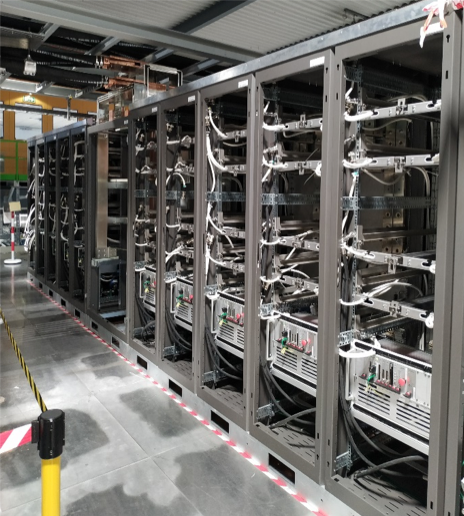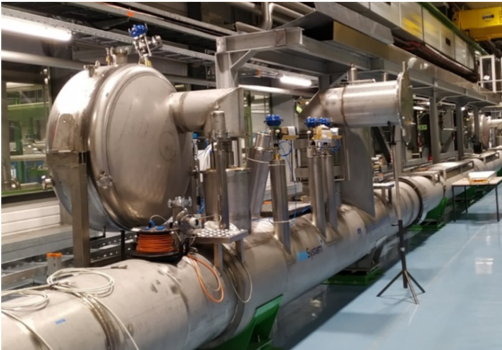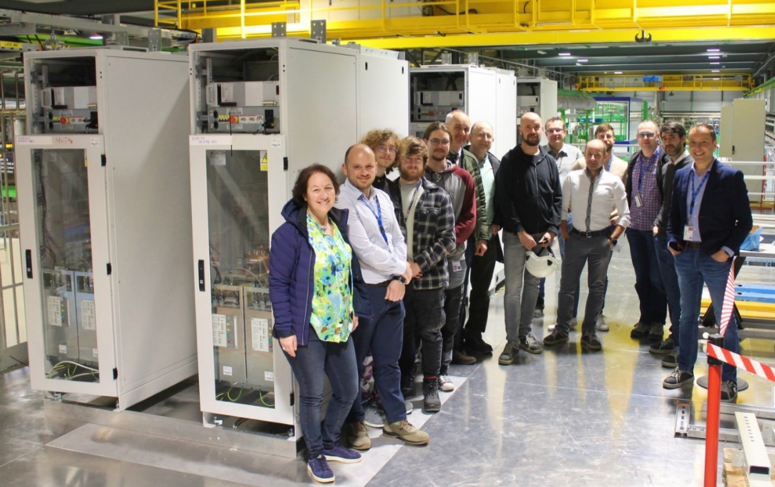As highlighted in the latest episode of the HL-LHC IT String, featured in Accelerating News, the installation and operation of this test stand mark significant milestones for the High Luminosity LHC (HL-LHC) project. State-of-the-art technologies will prove that they can effectively work in harmony, simulating diverse operational scenarios (in terms of cooling, powering, and protection of Inner Triplet (IT) magnets and circuits) that will take place in the HL-LHC.
If 2022 was a busy year with multiple installations completed, 2023 is poised to be just as eventful, if not more so. In fact, the majority of the equipment destined for integration into the metallic platform has already been installed.

Successful Installations
In early 2023, the Energy Extraction Systems (EEs) have been delivered and installed mirroring the procedure to be used in the machine. The EEs are part of the new protection scheme designed for the inner triplet region, specifically catering to the corrector magnets. A total of 7 of these equipment units were successfully positioned, with 6 allocated to the 2 kA circuits and 1 designated for the 600 A circuit.

Following this, the Power Converters (PCs) for the different circuits (i.e. 18 kA, 14 kA, 2 kA, 600 A, 120 A, and 35 A) were delivered and installed. These equipment supply power to the magnets as per the defined specifications. They have been specifically designed for the high luminosity LHC to ensure high precision and availability, compatible with magnets based on Nb3Sn coils. The modular nature of these PCs is evident in Fig. 2. The power modules will be mounted in the racks later in the year.
Furthermore, additional racks were installed on the platform to support various functionalities, including communications, measurements and alignment. As a result, a significant portion of the equipment on the metallic platform is now in place.
Finally, the primary campaign for the control cabling has been executed. These cables connect various equipment from the racks zone to the magnet line, ensuring seamless communication and control. The installation process involved laying down over 300 cables.
Towards Commissioning
Following the installation phase, the subsequent step involves the commissioning of the different systems. During this phase, installations of other systems will take place concurrently. As such, effective management of coactivities becomes crucial, ensuring smooth coordination and minimising any potential conflicts or disruptions. In addition to coordination, establishing all necessary safety measures is paramount to guarantee the well-being of personnel and the protection of equipment.
The commissioning phase has started for the Cryogenic Distribution Line (SQXL) following its installation last year. Various checks focusing on the line's vacuum are underway. The timeline for initiating operations under cryogenic conditions is set for summer 2023.
The initial stages will involve mechanical and thermal validation, ensuring the system functions as intended. Subsequently, control loop tuning will be carried out to optimise performance and ensure precise control over the cryogenic processes.
The demineralized water distribution network, including flexible pipes, has undergone successful pressure testing. This crucial step ensures the integrity and reliability of the system.
Navigating future challenges
As the installation phase progresses, a series of challenges lie ahead that require careful consideration and strategic planning. One significant task on the horizon is the second phase of commissioning for the Water-Cooled Cables (WCC). In the upcoming steps, the lugs and extremities for equipment connection will be meticulously oriented for the final connection by the equipment owner.
Another important milestone is the upcoming short circuit test of the warm part of the circuits, which involves PCs, WCC, EEs, CDBs, Air-Cooled Cables, and Busbars. This pivotal test is scheduled to take place in November 2023 and has its own dedicated procedure. Notably, a specially designed in-house short circuit connection framework will be used for this test.

Following this test, the focus will shift to the complex installation of the cold powering system, which includes the DFHX and the ScLink components. The unspooling of the ScLink on the metallic platform will be a demanding operation that requires the involvement of two overhead cranes and specialised tooling. The team is diligently studying the procedure and necessary equipment to ensure a successful installation. To mitigate risks and optimise safety, preliminary tests will be conducted under conditions closely resembling the real scenario.
While significant progress has been made through completed cabling campaigns, it is important to note that additional campaigns are planned to address any remaining installation requirements. Though these upcoming campaigns may be less extensive in nature, they play a crucial role in the finalisation of the overall installation process, ensuring seamless integration and optimal functioning of all components. Through careful planning, meticulous execution, and adherence to safety measures, the team is well-equipped to overcome the challenges and achieve project success.
More to come, stay tuned!
Find out more about the HL-LHC IT String: The HL-LHC’s IT String home gets ready, CDB installation in the HL-LHC IT STRING, participants HL-LHC IT String Day II, The IT String control room gets ready!

